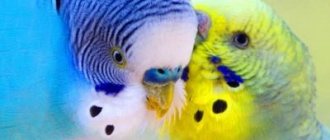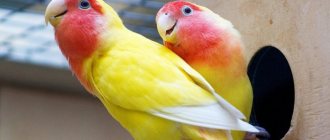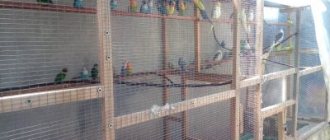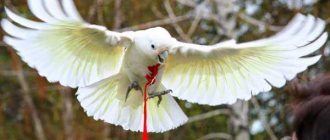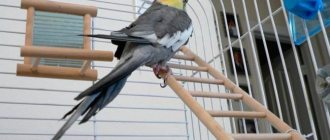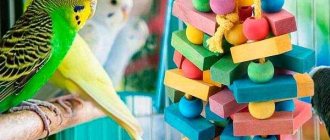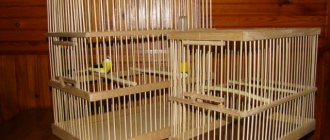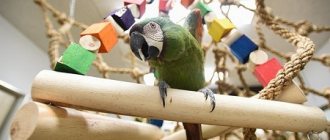In captivity, cockatiels reproduce successfully, but for this to happen several conditions must be met. You definitely need to install a nest for the cockatiel, because without it nothing will work. The nest box stimulates the nesting instinct in parrots, provides the female with calm and secluded incubation of eggs, and protects the chicks from external dangers. You can buy a simple box or birdhouse at a pet store, or order a fancy design made from environmentally friendly materials online. Or you can try making a nest yourself.
Why do you need a house?
Some birds make nests in the grass and do not need a house as such. Whereas representatives of the parrot family and cockatiels, among others, need an equipped, but most importantly, closed place for laying . Otherwise, the young may die or not hatch at all.
Corellas make nests in large branches of dried trees and stumps. The eggs are hatched by both parents, and the hatchlings are fed alternately.
You should take care of purchasing a nesting house in advance, at the stage of purchasing a cage. If the couple has taken place, then the appearance of the young animals will not keep you waiting long. Many manufacturers offer modular designs, where the house is mounted outside or inside the cage.
Breeding
The optimal microclimate parameters for breeding cockatiels at home are air humidity 60–70%, temperature 22–25 degrees. If you keep them level, the parrots will be comfortable raising their chicks.
Mating and oviposition
It's fun to watch cockatiels breed at home. The displaying male becomes very affectionate. He constantly tries to be close to his friend, fingering her feathers and cooing. The female favorably accepts the advances, kisses the male, and dances. Having surrounded his partner with care, the male cockatiel ends up on her back and, holding himself with his claws, mates. Intimate acts are repeated several times a day for one to two weeks.
10–14 days after the start of breeding, the female lays her first egg. Before this, she plucks the feathers on her belly to better warm the clutch. Anticipating an imminent birth, the female becomes quiet, rolls her eyes, breathes quickly and tenses. Every 1–2 days, one egg is added to the nest. In total there are from two to five eggs in a clutch. If there are more of them, there will not be enough heat for everyone, and the embryos may die.
Hatching and emergence of chicks
Having laid the egg, the female immediately begins incubation. She does this in turn with her partner: while he is sitting on the nest, she has a new egg ready. This is why it is so interesting to breed cockatiels at home: they tend to incubate together. Twice a day the bird turns over each egg, moving them from the middle to the edge and vice versa. The embryos should not stick to the shell, and they need uniform heating.
Before the end of the incubation period (21–23 days), the female tries not to leave the clutch, and the male feeds her. And then the day comes when the first chick is born. This event is marked by a thin squeak. The babies hatch one after another for several days, and when the last one breaks the shell, the already dry, eternally hungry brothers squeak in the nest.
Sometimes unfertilized eggs or those in which the embryos have died remain. The female continues to warm them, but if four weeks have passed and the eggs are intact, remove them.
Caring for chicks
Adult cockatiels feed their babies crop milk, a thick, cloudy white substance. Towards the end of the first week of life, small cockatiels receive solid food from their parents - semi-digested grains. At this time, as at the beginning of breeding, it is worth feeding the parents with sprouts again.
Two weeks pass, the birds become overgrown with down and partly with feathers. The whole family becomes cramped in the nest, and the older cockatiels move back into the cage. The young remain in the house. Curious birds lean out of the entrance, learn to get out, and sit on a perch. At one and a half months, the debut flight from the nest occurs, after which the chicks no longer want to return to the cramped home. They happily fly around the cage. Parents continue to feed them for up to two months.
What types are there?
In stores you can find nesting houses in a variety of designs. In relation to the cockatiel, you should focus on two main form factors - vertical and horizontal. If the bird is kept in a spacious enclosure, then it makes sense to consider solutions close to natural in the form of stumps.
Vertical houses
Here we have classic birdhouses, but with an eye to the size of the bird. The design is distinguished by its impressive depth and relatively small bottom area. The taphole is located in the upper part of the structure.
Regular birdhouses are not the best solution for cockatiels. The fact is that a high hole will make it difficult for the young to fly out of the nest when it is ready for this. In addition, there is a high risk of damage to the eggs when the female returns.
Jumping from a high entrance, she can simply crush them with her mass multiplied by acceleration. Therefore, such structures should be equipped with perches.
Horizontal houses
This is the best option for medium-sized parrots. Birds and young animals are comfortably accommodated in such structures. The only thing is that the owner will have to make sure that the chicks do not get out of the house earlier than expected due to the low-lying entrance.
It is also useful to read: Features of feeding cockatiels at home
Appearance of cockatiels
Making a cage for a parrot with your own hands
Today it is difficult to find a person who has not seen a cockatiel or heard about such an amazing bird. For several decades, the Karella parrot at home has not changed at all from its wild counterpart. An adult bird reaches the size of a small pigeon, which is about 30 centimeters. Most of the cockatiel's length is the tail. The weight of an adult pet will vary from 100 to 150 grams. Everyone recognizes the cockatiel by its long crest on its head, which is bright yellow.
Females and males can be distinguished by the color of their feathers. As you know, all males in the animal world are much more beautiful than females. The male cockatiel is no exception, his plumage is much darker, there are small patches of dark olive feathers, and his wings are decorated with black or blue-gray spots.
A female Corella at home looks much lighter than her companion. The female, unlike the male, has blotches of a different color on her cheeks, often orange or light brown.
In young individuals it can be very difficult to determine their sex, since they all initially acquire light plumage and only become darker over time.
Caring for the Australian bird
It would seem that an overseas bird will require a lot of attention and proper care, but the cockatiel by its nature is very unpretentious, but still some requirements in caring for it will have to be observed.
First of all, decide whether you want a pair of birds to bring you offspring. If you want, you need to take care of the nesting house for cockatiels. No matter what this Australian bird is called, it is still a parrot that breeds only in a tightly closed room. Unfortunately, not every store will be able to offer you a ready-made nesting house, because its dimensions depend on the size of your cage or enclosure; it is much easier to make it yourself.
Instructions
Don’t panic and scour the DIY book for the necessary instructions. A house for a cockatiel with your own hands can be made according to the square principle. Simply take 6 equal squares and glue them together. Make sure that there is no glue left on the edges; if you decide to fasten it with nails, then do not allow any sharp parts of the nail to protrude. It is also worth taking care of the material from which you will make the house for Karella parrots. It is better to choose natural materials without staples and various damage; the bird can injure itself and injure its young.
Making a house is another part of the work, the second part is filling it with materials in which the bird would hatch its eggs. Making a nest for a cockatiel with your own hands is as simple as making the house itself. Place birch sawdust inside the nesting house in a layer of 3-4 cm with the addition of one teaspoon of chamomile. The bird will make all the indentations itself.
Care in captivity
By purchasing a cockatiel, you have committed yourself to raising this amazing bird, also called a nymph. You should understand that a medium-sized cage will not work for such a bird, and if you are also going to breed chicks in it and house a second individual, then it is better to give preference to an aviary. Do not think that pet cockatiels will just sit on a perch and chirp sadly, they are quite active birds and to live a full life in captivity they need swings, ropes and other cockatiel toys.
It should be remembered that the bird needs at least 12 hours of light; it should not be placed in a dark room or covered with a dark cloth for half the day. When the cockatiel is at home for the first few days, you should not bring the bird to nervous stress. Undoubtedly, a funny chick with a tuft on its head will be interesting not only to a child, but also to an adult, but a change of environment for a bird is a lot of stress, and if you climb into it and say, “Let me pet you,” then this is fraught with a stressful illness that does not always end well .
Nutrition during the breeding season
Having built a nesting house for cockatiels, it is not at all necessary that the bird will immediately fly there to hatch eggs. A parrot, like a person, independently chooses a life partner, and if he did not like the couple that you recommended as the father of the family, then you will only have to enjoy these birds, but not their offspring.
The lack of offspring can also be associated with poor nutrition. It is not enough for them to just feed in the form of grain crops; their diet should also include cottage cheese, fruits, and various cereals. By taking care of your cockatiel's varied diet, she will soon thank you with new offspring.
Material requirements
First of all, these are the materials used. It is better to immediately abandon budget solutions made of plastic. The latter, especially on hot summer days, emits toxic fumes that can poison both parents and young animals.
Cardboard
The cardboard structure is a temporary solution. It will come in handy when the female has already laid eggs, but there is no full-fledged nesting house for the parrot yet. Such scenarios are most often observed among inexperienced breeders.
As soon as the young animals appear, the cardboard house should be replaced with a more reliable and practical design. Otherwise, the parrots will begin to eat away at the edges, absorbing harmful substances. In addition, it is impossible to carry out wet cleaning and full disinfection in cardboard structures.
As the backbone for a cardboard house, you can use boxes from electric kettles, microwave ovens and other equipment of similar dimensions.
Plywood
This is the best option for a nesting house located in an apartment. If the cage is located, for example, on a veranda, where humidity and temperature are unstable, then the plywood sheets may become deformed.
You should also be careful when disinfecting and wet cleaning the house. Plywood does not tolerate contact with water : the structure becomes loose, and fungal formations may appear on the walls. Premium options are coated with a special varnish, which partly eliminates the problem with moisture.
Tree
The ideal option is a piece of wood with a cleft/hollow. The easiest way to find a poplar stump in the city. This house is as close to natural as possible. Before installation in the enclosure, the stump must be thoroughly disinfected to prevent infestation by parasites.
Did your parrots have chicks?
Not really
Proper arrangement of a nest for a cockatiel parrot
If you have got yourself a couple or even more feathered pranksters, then you will certainly sooner or later encounter the fact that they will try to lay eggs. Surely this turn of events will be unexpected, but happy for you.
In order to worry about preparing a nest or a full-fledged nesting house for your parrots in advance, you will need to study the habits of your feathered charges.
In their natural habitat, cockatiels breed during the rainy season. This happens for a fairly simple and even banal reason. It is during this period that the amount of food increases, which is so necessary to maintain the strength of both the parents and the chicks that are born.
At home, this period can easily be shifted. After all, it is in your hands that you will be able to regulate both the quantity and quality of your cockatiel’s food, as well as the duration of their daylight hours. Thus, if you want to breed cockatiels, you can ensure that they lay eggs a couple of times a year. However, you shouldn’t overwork them too much. Excessive stress on the body is harmful to females.
Over time, you will even be able to accustom your charges to a certain routine. For example, by gradually increasing and feeding cockatiels with protein foods, such as boiled eggs and cottage cheese, you will increase their mobility and energy
Next, you will need to take care of the location of the nesting house inside the cage, which will subsequently certainly attract the attention of the female. After these manipulations, you are unlikely to need to wait a long time before the pair you have tamed produces offspring
Store-bought or homemade
The design of the nesting house cannot be called complex, unlike the same cage. Therefore, prices in stores for the former are much more attractive than for the latter, even if we take into account the premium segment. For example, a high-quality design in all respects with additional accessories from the Italian brand Ferplast will cost 1-1.5 thousand rubles.
Having minimal experience in carpentry and the accompanying tools, you can make a nesting house yourself. The design consists of 6 blank walls and a hole, so no serious difficulties should arise, either with the purchase of material or with assembly.
Choosing the right pair
Physical aspect
To get healthy and strong chicks, you need to select physically and mentally healthy birds for mating
When choosing future parents, pay attention to their condition. Corellas injured or weakened by disease cannot produce normal chicks
Even if there are no visible signs of disease or damage, it is better to be on the safe side. Get your birds tested at the nearest veterinary hospital to identify possible hidden diseases.
Avoid breeding closely related cockatiels - inbreeding. This type of mating is used by scientists to fix some mutation: lutino, albino, and so on. For you, such a procedure is meaningless. Moreover, inbreeding has negative consequences for future parents: in female cockatiels, egg production decreases, and in males, egg fertility decreases. And chicks may develop health problems and congenital defects:
- deformation of the stratum corneum, wings, paws;
- problems with the musculoskeletal system;
- malfunction of vital organs;
- sterility;
- decreased immunity.
Suitable age
Cockatiels are ready to breed as early as nine months. However, breeding young birds is not recommended. There is a high risk of giving birth to weak chicks, and their mortality increases. Young parrots quickly exhaust their bodies. After all, they spend on the chicks the body’s resources, which they still need for their own development. The younger nine-month-old generation may poorly care for the chicks, which is why they die.
It is better to allow cockatiels to be bred starting from the age of one year. By this point, the bird’s body is already quite strong.
The ideal age for breeding parrots is one and a half to two years. You will have time to prepare your cockatiels for mating with a properly balanced diet. Especially if you are not sure that the pets' former owners fed them well. The rules for creating a diet can be found below.
Regular walks around the room would also be useful: running on the floor, flying. Especially if the parrots are obese, which reduces the chance of normal breeding. Physical activity has a beneficial effect on the condition of cockatiels, training their muscles and getting rid of excess weight.
Moral aspect
Cockatiels are loyal birds; in the wild, they try to find a mate for life. Therefore, at home, it is advisable to provide them with the opportunity to independently choose a partner. For owners who want to start breeding these birds, keeping many parrots in an aviary would be optimal. In this case, they will be able to choose a mate on their own.
If you are just going to buy a pair for your pet, then you need to introduce them gradually. Immediately introducing a new resident into the cage can provoke a fight for territory. It is better to place two cages next to each other or introduce the cockatiels while freely walking around the room.
Over time, the male will begin to care for the female: feeding, cleaning her feathers, dancing, cooing. If the female reciprocates, then the couple has taken place.
How to make it yourself
Let's consider one of the simplest options for assembling a nesting house for medium-sized birds. To make the routine easier, it is more practical to use a power tool. With a screwdriver, saw and hand jigsaw the result will be similar, but it will take much more time and effort.
Dimensions
Breeders recommend adhering to the following dimensions: 35 cm – length of the house, 25 – width and 25 – height, with a taphole diameter of 7 cm . There is a lot of controversy about the form of the latter. Some say that the tap hole should be round, while others claim that a square hole also has the right to be. The second option is naturally easier to organize than the first.
The shape of the nesting house itself is rectangular or square. As mentioned above, vertical solutions are not the most interesting option for parrots.
Materials and accessories
The most common, and at the same time the most affordable option for most owners is plywood. It is better to focus on solutions for furniture needs rather than construction ones. The former will last longer and are easier to work with.
Materials and accessories for making a nesting house:
- sheet of plywood 10-12 mm thick (1220 x 2440 mm);
- wood screws (with large threads) 30-35 mm – 30 pieces;
- furniture hinges for the lid - 2 pieces;
- corners for attaching to the cage – 4/6 pieces.
In large hypermarkets, like Leroy or Castorama, you can immediately unroll the sheet to the desired size. This scenario will significantly facilitate transportation and further assembly.
Tools:
- wood hacksaw;
- jigsaw (for a round tap hole);
- screwdriver;
- drill with a drill for a self-tapping screw (diameter 3-3.5 mm);
- file;
- sandpaper (zero grade).
Manufacturing process with photo
If the plywood has not previously been cut into blanks, then mark the sheet and cut it with a saw into 3 pairs of parts according to the dimensions: 350 (L) x 250 (W) x 250 (H) mm. On one sheet you need to make a hole - a tap hole, located closer to the edge.
A smaller sheet of plywood should be attached to the bottom to mark the hatching area. You can also drill a hole if you have a circular drill of the required diameter at hand (as in the figure). Hinges must be attached to the lid. If the nesting house will stand separately from the cage, then a perch will be needed. We make a hole and secure it with a piece of plywood and self-tapping screws.
All parts must be processed with a file, and then sanded with sandpaper. Otherwise, birds and young animals will plant splinters.
We assemble the body using self-tapping screws, not forgetting to drill holes for them. In the absence of the latter, the plywood may crack. Place the lid on the hinges against the back wall. We screw the corners and secure the house next to the cage.
Care immediately after purchase (adaptation)
How to make a playpen for a puppy with your own hands
On the first day after purchase, the nymph experiences severe stress. He will have to get used to his new habitat for several days. During this time, you should not approach the cage unless necessary.
You will have to move around the room as carefully as possible; it is better to enter it only during feeding. When adding food or changing water, you need to talk quietly to the bird in a gentle voice so that it gets used to its owner
In the first days, the young chick will huddle in the corner of the cage. He should be left alone and fed every 3 hours for the first 10 days. Small portions of food help to establish contact between birds and humans more quickly. Every day the parrot will become calmer and calmer until it finally begins to freely let its owner approach.
Conditions of detention
In general, cockatiels are unpretentious, but they still require certain conditions for comfort.
Did you know? Corellas distinguish all their chicks, even if they have absolutely identical colors, and moreover, they assign names to them. Each chick receives its own unique sound combination, with which its parents call it throughout the entire period of growing up. As cockatiels grow older, they lose the ability to recognize their infant name.
Climatic
The maximum comfortable humidity for a cockatiel is 70%, temperature is within 23 degrees. Most living spaces have these parameters, so feel free to place a cage with a cockatiel in the room. Avoid drafts and direct sunlight, as under their influence the bird will become ill. The cockatiel cannot tolerate dust, so regularly carry out wet cleaning near the cage.
What should a cell be like?
The requirements for choosing a cage for cockatiels are as follows:
- The dimensions of the cage should be as spacious as possible. The more space the bird gets, the better it will feel. The minimum dimensions are 60 cm in height, 50 cm in width and 50 cm in depth;
- Give preference to vertical cages so that your pet can fly whenever he wants. Let him out for a walk around the apartment twice a day so that he doesn’t start feeling bored without moving;
- buy cages with a gap between the bars of 2–3 cm. If the gap is smaller, the bird may injure its long toes; if it is larger, the head or wing will get stuck;
- A prerequisite for a comfortable cage is wide, strong perches made of wood. Cockatiel chicks love to chew on perches, so the use of plastic accessories is unacceptable. Place them so that, while sitting on the perch, your pet can freely spread its wings.
Important! Curious cockatiels love a variety of toys, but you need to add them to the cage gradually so that the chick does not become stressed by a lot of unfamiliar things. What should a cockatiel cage be like: video
What should a cockatiel cage be like: video
Hygiene procedures and care
The cage should be cleaned daily. Sweep the remaining food out of it, remove droppings, wash the feeder and pour fresh food into it. Once a week, carry out general cleaning, placing the chick in a temporary cage - wipe the bottom and bars. Every month, disinfect all surfaces of the cage, wash toys and accessories in soapy water.
Did you know? In the wild, cockatiels exhibit a remarkable addiction to alcohol. They become intoxicated by gorging themselves on fermented fruits or nuts, and then fly around uncontrollably and become rowdy. In Australia, every now and then there are whole “rains” of drunken parrots, during which the birds lose their orientation and fly into residential areas of cities. At home, with an open drinking bowl freely available, these cunning creatures can prepare their own mash by throwing pieces of fruit into the water and waiting for them to ferment.
These birds' claws grow throughout their lives, and there is no way to grind them down in a cage, so trim them once a month with a cat's nail clipper. While trimming, be careful not to touch the blood vessel that supplies the nail. Chicks are sensitive to stress, remember unpleasant sensations, and repeating the haircut next time will be problematic.
There is no need to wash the cockatiel under running water and with detergents. The bird takes good care of itself and cleans its dry plumage on its own. From time to time she needs to give her a spray bottle shower. If your pet is seriously dirty, you can put a bath in its cage with a weak soap solution - the chick will wash itself in it and then dry.
Parrot diseases and their prevention
When there are other birds in the apartment and the owner bought a Corella parrot, he should definitely be kept in a separate cage away from other individuals (in quarantine) and observed. If the bird feels normal, then it can be transferred to a common cage, introducing it to its “neighbors”.
It is possible that for the first 2-3 days the Corella parrot will refuse to eat, behave noisily, and scream loudly in different ways. This is a normal phenomenon: this is how adaptation to new conditions occurs. After a few days, his condition and nutrition return to normal.
A representative of the Cockatoo family is a fairly strong and hardy bird that rarely gets sick. If it becomes noticeable that Corella
- sleeps a lot;
- stops cleaning feathers;
- breathes with difficulty;
- sneezes and discharge appears from the beak;
- liquid excrement with a pungent odor;
- shows apathy and weak reactions,
This means it’s time to seek help from a veterinarian or ornithologist so that he can examine the sick parrot and determine a possible disease.
Important: Usually there are difficulties with the feathers of a bird associated with the molting period and self-plucking. Sometimes the disease is caused by problems with the stomach and intestines: gastroenteritis and dysbacteriosis develop
These pathologies are the most common.
Preventive measures include good living conditions, balanced nutrition and high-quality feed, and periodic visits to the veterinarian.
A stump is a natural nesting house. This is really cool!
For many, keeping a cockatiel is hampered at the level of “cache in a cage”, in our case “cache and clash in a cage with a breeding box”, but some really try to recreate a part of the Australian homeland for their pets: they build game stands, and even entire trees , vegetable gardens with herbs, enclosures on the balcony, etc.
As for the nesting house - for cockatiels and other parrots it is possible AND NEEDED, if of course you have the opportunity and desire to make a real nest box, and not just a nest box - a real hollow, exactly the same in which they raise their chicks in the wild.
I’ll say right away that in the two years since we came up with this idea, we still haven’t gotten around to making a natural nesting box, but one person on the Internet who also makes nests for cockatiels with his own hands has implemented this idea quite coolly. By the way, subscribe to his YouTube channel - he seems to have a correct understanding of bird keeping, I think you will be interested.
Here a friend shows his cockatiel enclosure (by the way, it’s well made, many people make mistakes with the size of the mesh cells and take the first thing that comes to hand in a hardware store, and then the chicks’ heads get stuck there), and a homemade nesting box for a cockatiel made from boards or plywood he doesn’t do it fundamentally and rightly so!
And here he tells how he begins to make nesting houses, and even real hollows from stumps (poplar)! The truth is not for the cockatiel, but for Jaco, Amazons and Kaikov.
Here he shows the process of making log nests
And the final stage, here a friend shows a nest box installed in the enclosure:
The fact that he did it was really cool and correct - we had been planning to create the same thing for two years now, only in the process of riding through the forests on a bicycle, I kept dreaming of finding a real hollow, with a rotten middle - so that it would be just like in nature and stumps could be Don’t split it into two parts.. but it looks like I’ll be driving through the woods like this for another 10 years and won’t find anything. The friend's method can be considered optimal.
Nesting Tips
Here are recommendations that will be useful for a beginner in breeding cockatiels:
The bottom of the nest is covered with sawdust, as mentioned above. Only the fraction should not be large to avoid injury to the birds’ paws. The medium and fine fractions are quite suitable. You can buy such sawdust at a pet store. They are used for rodents. If the birds are absolutely tame and are constantly in free flight, then you can make a nest in any place convenient for them. It is important for the owner to remember that during the nesting period his pets become real monsters. Especially the expectant father, who attacks the owner and household members with shrill screams. The male uses his beak and claws to defend the nest. Therefore, there is no need to place it in the bedroom, near the computer, or in the kitchen. In general, where people have to be quite often. It is imperative to monitor the humidity in the nest. Another option is to hang a humidity measuring device nearby. Optimal indicators are from 50 to 60%. If the humidity is low, then the nest should be sprayed with a spray bottle. In moderation, of course. If the owner finds a laid egg at the bottom of the cage, then you need to carefully transfer it to the nest. So as not to fall under the menacing gaze of the guard parrot.
Sizes of nesting boxes for parrots
| Types of parrots | Nest house dimensions (cm) | Taphole diameter (cm) | Hole diameter (cm) |
| Wavy, passerines, lovebirds | 17x25x17 | 4 — 5 | |
| Herbal | 20x30x20 | ||
| Corellas, warblers, ringlets, Senegalese, rosellas, lorises, lorikeets | 25x40x25 | 6 — 8 | 8 — 9 |
| Grays, Amazons, Lesser and Yellow-crested Cockatoos | 30x50x30 | 9—11 | 8 — 9 |
| Large cockatoos, small macaws | 40x60x40 |
Zoos use different size proportions for parrot houses. Medium-sized parrots - ringed, Senegalese, rosellas and cockatiels, breed in houses with bottom dimensions of 24 x 24 cm and a height of 150 cm. The diameter of the entrance is 8 cm. For grays, the dimensions of the nest box are 30 x 30 x 150 cm. Nest boxes are made made of thick plywood, there is a net inside from the entrance to the floor of the house, along which it is convenient for birds to climb down. There is a door at the bottom of the house - it is needed to control the nesting of parrots. A layer of sawdust is poured onto the bottom. When making nesting houses, it is necessary to make sure that access to eggs and chicks is quite simple and the procedure for inspecting the nest itself does not take much time. It is better if the house has a removable lid. Of the domesticated housebirds, many wax-billed weavers also nest in houses: finches, damsels, munias, amaranths, and astrilds. The houses are made of planks or plywood 6-8 mm thick. Their sizes may be different, but the best and most universal would be a square house with walls 12 cm long. The entrance can be rectangular or round, with a diameter of 5 cm.
For forest and bush birds that build cup-shaped or spherical nests in the aviary, it is necessary to provide forks of branches where the birds can build their home. Sometimes a whole bush, a bunch of tree branches tied together, or thick reeds are installed in the bird room. The latter is good for nesting of some true weavers, whiskered and thick-billed tits, and warblers. Many birds prefer to build nests on their own - wicked parrots, true weavers, tiger astrilds and others. However, to begin nesting of canaries, many finches, cardinals and buntings indoors (cage or aviary), you need to install the bases for canary-type nests - in the form of a cup. An artificial nest can be woven or swept with threads from a regular clothesline. Its dimensions must correspond to the size of the bird. Thus, the nest for canaries and other finches should be 10 cm in diameter with a tray depth of 5 cm; for cardinals and blackbirds, the nest diameter should be 12 cm and the tray depth 6-7 cm. Sometimes hobbyists use old bird nests found in nature. But before doing this, the nests should be disinfected and freed from parasitic mites and insects.
To raise chicks without a brood hen, various heaters are used: IKUF, in which infrared and ultraviolet lamps are mounted; contact heaters in the form of a heating pad or those made independently are good. You can also use ordinary electric light bulbs of 25-40 W, raised to a height inaccessible to the chicks. In the first days of life, down jackets require heating, since their own thermoregulation has not yet been established. In breeding birds (quail, partridge), they themselves find a place in the cage with the desired air temperature.
